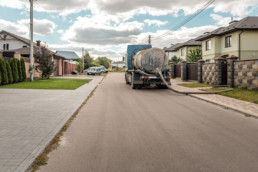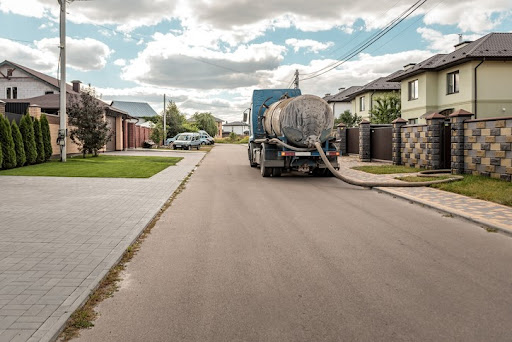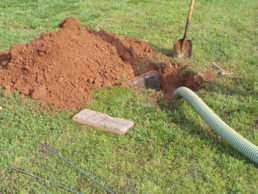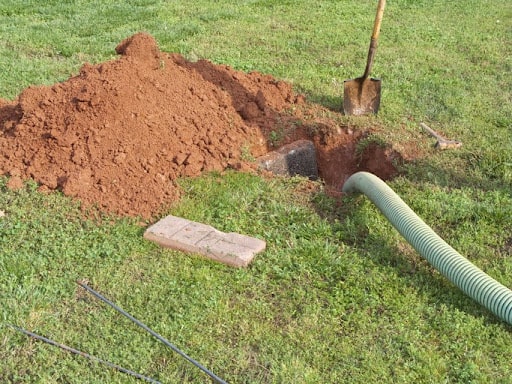Septic Tank Pumping: How It Works and What to Expect?
A well-designed and properly installed septic tank can last for decades—or it can fail in just a few years. It all depends on whether you prioritize septic tank inspections and maintenance.
Routine septic pumping is one of the most important parts of maintaining your septic system. The Environmental Protection Agency (EPA) recommends doing this every three to five years based on the size of your household, how much wastewater you generate, the volume of solids in your wastewater, and the septic tank size. But what does septic pumping entail? Take a closer look at how this process works and what to expect.
Step 1: Open the Septic Tank Access Lid
The first step is to locate and access the septic tank. The access lid is usually located near the home’s main sewer line and may be buried under six to 12 inches of soil. If needed, your service provider may use a metal detector to locate the lid.
Once found, crew members carefully remove the access lid. They also inspect it for corrosion, cracks, or other damage that could warrant a replacement.
Step 2: Pump Out the Tank
The next step is to pump the tank using a high-powered hose connected to a vacuum truck. This sucks out solid waste, liquid, and scum and pumps it into the truck’s holding tank. Removing as much accumulated waste as possible is important to prevent blockages and backups in the septic system.
Step 3: Clean the Tank
Your service provider now cleans the tank using high-pressure water to remove any remaining debris or build-up. Septic tank cleaning is crucial to maintain system efficiency and prevent future problems.
Step 4: Conduct a Visual Inspection
Next, the crew visually inspects the tank’s interior and exterior, checking for any cracks, leaks, or other damage that could affect functionality. Your contractor may recommend repairs or replacements if they find any problems during this inspection.
Step 5: Close and Rebury the Lid
When the inspection is complete, the crew replaces the access lid and reburies it. You may request a riser installation to lift the lid above ground level for easier access during future upkeep. Your service provider should ensure the area is clean and tidy before driving away.
Step 6: Dispose of Scum and Sludge
The final step in the septic tank pumping process is to discard the scum and sludge in a proper and environmentally safe manner. Waste is usually taken to a treatment facility for processing and disposal according to local regulations.
Hiring a professional septic tank pumping company ensures the process outlined above is performed correctly and efficiently. Turn to Trinity Liquid Waste for a job well done. Our family-owned business has over 25 years of experience serving residential and commercial customers in the San Francisco Bay Area. We specialize in septic pumping, septic inspections, septic repairs, and other plumbing-related services. Whether you need a routine visit or an emergency response, we have you covered! To schedule septic services with us, please call 510-874-6489 or contact us online.
6 Signs You Need Septic Tank Pumping
The Environmental Protection Agency (EPA) recommends septic tank pumping every three to five years, depending on your family size, water usage habits, the condition of your tank, and whether you use a garbage disposal. This service keeps your tank clean and running smoothly to prevent plumbing problems and water contamination issues. Watch for these six signs that you need septic tank pumping so you know when to schedule an appointment.
Standing Water in the Drain Field
The drain field is where wastewater from the septic tank is dispersed and treated by the soil. If a septic tank overflows, water may back up into the drain field, causing pools in your yard. If you notice standing water in the drain field, have the tank cleaned before other septic problems develop.
Bright Green Grass
Overly lush grass, excessive weeds, or flowers blooming in the drain field can be a sign that your septic tank is leaking or needs to be pumped. Nutrients and water from a full septic tank release into the drain field, resulting in this bright, flourishing appearance. While it may seem like a good thing, fast-growing grass actually means the septic tank is not functioning properly and should be pumped soon to prevent damage to the drain field.
Foul Odors in the Drain Field
Unfortunately, a lush lawn isn’t the only symptom of sewage seeping up from your septic tank. If a foul smell permeates the yard, this is a sure sign that your septic tank is full and needs to be emptied.
Gurgling Drains
Don’t ignore strange noises coming from your drains. This septic tank warning sign could indicate obstructions in your plumbing system, causing gurgling sounds as water drains from sinks, toilets, and bathtubs. Have your septic tank inspected by a professional to determine if it needs to be cleaned.
Slow Drains
Slow sinks and sluggish toilets are telltale signs that your septic tank needs pumping. As the tank reaches capacity, it can cause blockages in the plumbing system, resulting in slow drains and backups. Try using a septic-safe drain cleaner, and if that produces no change, call a professional to pump the tank.
Sewage Backup
If you don’t heed your slow, gurgling drains, you could end up with a full-blown sewage backup. This occurs when the septic tank is so full that wastewater has nowhere else to go but back up the pipe and out the drain. You can prevent sewage backups by being careful about what goes down the drain and pumping your septic tank according to the recommended schedule.
If you notice any of these signs, turn to Trinity Liquid Waste for septic tank pumping in the San Francisco Bay Area. Our family-owned business has over 25 years of experience serving residential and commercial customers with high-quality septic system services. We’ll work with you to determine the best septic pumping schedule for your needs so you never have to worry about an emergency developing. For more information or to schedule septic services, please call us at 510-874-6489 or contact us online.
What to Expect from Professional Water Jetting Services?
If the pipes at your business are blocked or draining slowly, someone has probably recommended you get a high-pressure water jetting service, also known as hydro jetting services. If you’ve never had this service done, here’s what to expect.
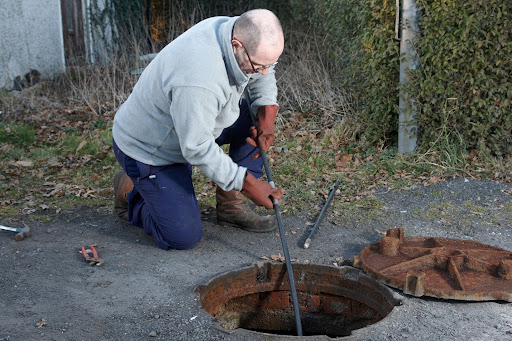 What is Hydro Jetting?
What is Hydro Jetting?
There are many ways to service a slow draining pipe. A chemical solvent such as Drano or Liquid Plumr can be used, but the chemicals can damage your pipes or the environment. An electric plumber’s snake (also known as an auger) can be used, but it can get stuck in the pipe, or lead to injury when it recoils.
The water jetting process involves a high-pressure hose with special nozzles. Like the snake, it gets inserted into the pipe to break up the clog, but it’s less likely to cause damage or get stuck. If one hose attachment doesn’t clear the clog, there are a number of other kinds that may be used. Typically, they spray a high-pressure beam of water straight ahead, with additional streams that spray in all directions. It’s even strong enough to pulverize small roots, and blast them out of the pipe as well. It can break up and remove old grease that has congealed, along with hair and other debris.
Another advantage of hydro jetting over plumbing snakes is that the high-pressure water shooting in all directions is more likely to expel soft obstructions instead of merely breaking them up. This gets rid of odor-causing materials. And it doesn’t pose the health or ecological risks that chemical cleaners do. One minor drawback of hydro jetting is that it can’t be used where there’s a flooding risk, such as a basement or crawlspace.
As Part of Maintenance Routine
Hydro jetting isn’t only used for blockages. They can also be used to keep your pipes clear of debris. This keeps your plumbing working efficiently and means that major plumbing work will be less necessary in the future. If your plumbing involves a lot of grease, hair, dirt or other troublesome materials, you might want to have your pipes hydro jetted every year or so.
Don’t let a slow or stopped drain affect your staff’s or customers’ ability to work and use the bathroom or kitchen. Trinity Liquid Waste has your clogged pipes covered with quick and affordable water jetting throughout the Bay Area. We provide 24/7, same-day service to ensure we clear your pipes as soon as possible. You can always count on us to respond quickly and determine the best service for your drains’ or septic system’s needs. Contact us today to learn more about hydro-jetting for your drains or schedule service at your location.
We also offer septic pumping and septic inspections to residential and commercial customers in the Pleasanton, CA, area. Drawing on over 25 years of experience, we have the knowledge and skills needed to keep your septic system in good shape. Contact us at 510-874-6489 to schedule services with us today.
Why You Need Regular Grease Trap Cleaning?
If you’ve worked in restaurants for a while, you know why it’s essential to keep grease traps clean. But for many people, this is a new subject. Here are a few reasons why grease trap cleaning services are so important.

Safety First
Grease traps that get too full endanger your indoor air quality. They’re also much more likely to catch fire compared to well-maintained traps. You can avoid these risks by having your grease trap regularly cleaned, for a safer work environment.
Unpleasant Odors
Many grease traps contain rotten materials that emit nasty odors. These smells can fill your establishment and make it an unpleasant environment for customers and workers. These rotting substances also pose health hazards, so cleaning your grease trap removes both the odors and the health risks.
Utility Issues
A clogged grease trap is not only smelly and dangerous. It creates functionality problems for your business. Drains need to work properly. Clogs cause waste materials to flow back up from your drains. Regular trap cleaning prevents this. Another thing to remember is that traps packed with grease are harder to clean. Well-maintained traps are much easier to clean, meaning the job will take less time.
Legal Risks
There are laws and regulations pertaining to grease spills. If your business is determined to be the cause of a grease spill, you can face legal consequences.
Financial Costs
Not only can you be fined for a grease violation, but your business can be shut down and your reputation can be harmed. This can cost you a lot of business. Another financial risk comes from repairs that may be needed if your grease traps and drains are damaged from lack of maintenance. When rotting food is left in a trap, it can create sulfuric acid, which can damage the walls of the trap. This can cause some components to fail and need to be replaced.
Trinity Liquid Waste has been a reliable plumbing source for commercial customers for 25 years. Our decades of plumbing and septic expertise encompass a wide array of services applying to various industries, including grease trap pumping. Whether you need daily pumping due to high volumes of grease, or you only need to empty your tank periodically, our team of technicians is ready to help you. We arrive on time for scheduled grease trap and tank maintenance and pumping and work quickly and efficiently to minimize any disruption to your business. We also offer septic pumping and septic inspections to residential and commercial customers in the Pleasanton, CA, area. Drawing on over 25 years of experience, we have the knowledge and skills needed to keep your septic system in good shape. Contact us at 510-874-6489 to schedule services with us today.

